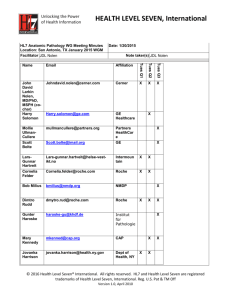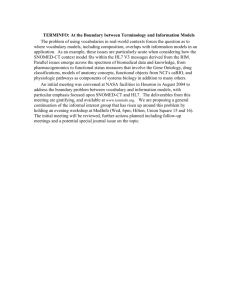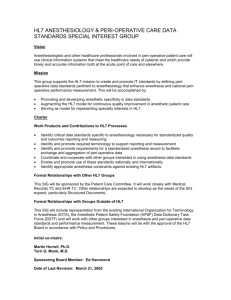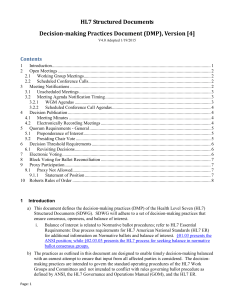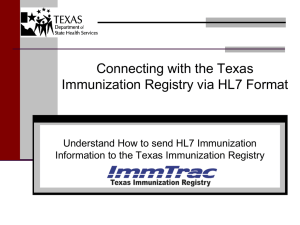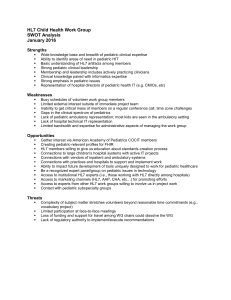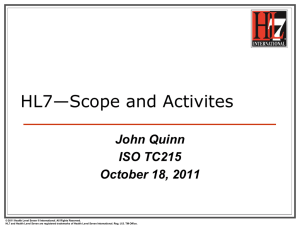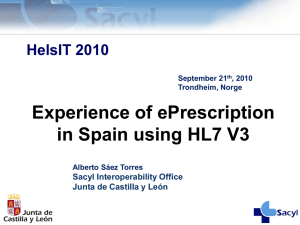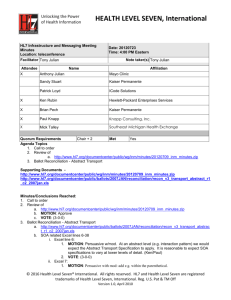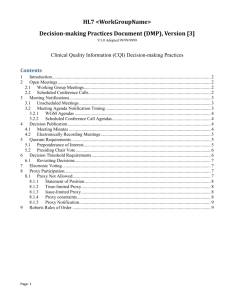Decision Making Practices 3.0
advertisement
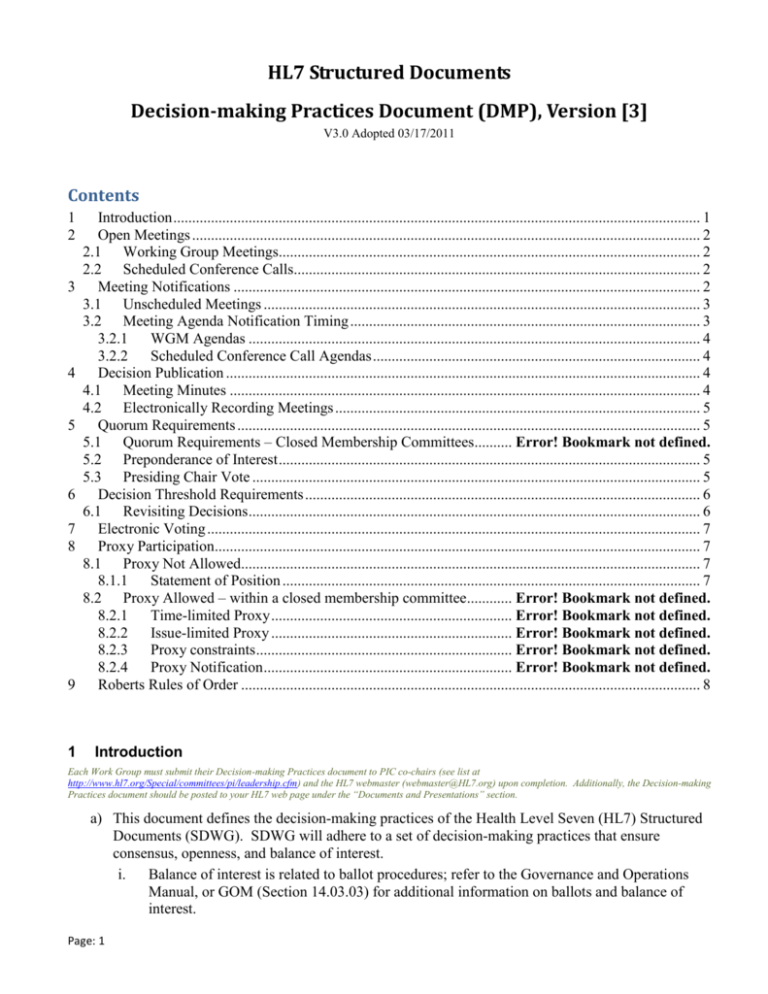
HL7 Structured Documents Decision-making Practices Document (DMP), Version [3] V3.0 Adopted 03/17/2011 Contents 1 2 3 4 5 6 7 8 9 1 Introduction ............................................................................................................................................ 1 Open Meetings ....................................................................................................................................... 2 2.1 Working Group Meetings................................................................................................................ 2 2.2 Scheduled Conference Calls............................................................................................................ 2 Meeting Notifications ............................................................................................................................ 2 3.1 Unscheduled Meetings .................................................................................................................... 3 3.2 Meeting Agenda Notification Timing ............................................................................................. 3 3.2.1 WGM Agendas ........................................................................................................................ 4 3.2.2 Scheduled Conference Call Agendas ....................................................................................... 4 Decision Publication .............................................................................................................................. 4 4.1 Meeting Minutes ............................................................................................................................. 4 4.2 Electronically Recording Meetings ................................................................................................. 5 Quorum Requirements ........................................................................................................................... 5 5.1 Quorum Requirements – Closed Membership Committees.......... Error! Bookmark not defined. 5.2 Preponderance of Interest ................................................................................................................ 5 5.3 Presiding Chair Vote ....................................................................................................................... 5 Decision Threshold Requirements ......................................................................................................... 6 6.1 Revisiting Decisions ........................................................................................................................ 6 Electronic Voting ................................................................................................................................... 7 Proxy Participation................................................................................................................................. 7 8.1 Proxy Not Allowed.......................................................................................................................... 7 8.1.1 Statement of Position ............................................................................................................... 7 8.2 Proxy Allowed – within a closed membership committee............ Error! Bookmark not defined. 8.2.1 Time-limited Proxy ................................................................ Error! Bookmark not defined. 8.2.2 Issue-limited Proxy ................................................................ Error! Bookmark not defined. 8.2.3 Proxy constraints .................................................................... Error! Bookmark not defined. 8.2.4 Proxy Notification .................................................................. Error! Bookmark not defined. Roberts Rules of Order .......................................................................................................................... 8 Introduction Each Work Group must submit their Decision-making Practices document to PIC co-chairs (see list at http://www.hl7.org/Special/committees/pi/leadership.cfm) and the HL7 webmaster (webmaster@HL7.org) upon completion. Additionally, the Decision-making Practices document should be posted to your HL7 web page under the “Documents and Presentations” section. a) This document defines the decision-making practices of the Health Level Seven (HL7) Structured Documents (SDWG). SDWG will adhere to a set of decision-making practices that ensure consensus, openness, and balance of interest. i. Balance of interest is related to ballot procedures; refer to the Governance and Operations Manual, or GOM (Section 14.03.03) for additional information on ballots and balance of interest. Page: 1 HL7 Structured Documents Decision-making Practices Document (DMP), Version [3] V3.0 Adopted 03/17/2011 b) The practices as outlined in this document are designed to enable timely decision-making balanced with an earnest attempt to ensure that input from all affected parties is considered. The decisionmaking practices are intended to govern the standard operating procedures of the HL7 Work Groups and Committees and not intended to conflict with rules governing ballot procedure as defined by ANSI and the HL7 Governance and Operations Manual (GOM). c) In the event of joint meetings, the DMP of the host Work Group shall be the governing document. 2 Open Meetings a) Work Group meetings and conference calls are open to all interested parties. b) The purpose of these Work Group meetings and calls is to transact business including the resolution of design and implementation issues related to the Work Group’s area of responsibility and to make decisions relevant to the Work Group's business. c) Meetings of the Work Group are open to everyone to ensure that viewpoints of all affected parties have an opportunity to be shared and considered. Everyone will be given an opportunity to speak; however, the chair may limit discussion on topics deemed to be non-constructive. d) Depending on the purpose or mode of the meeting certain participants are expected to attend. e) Other HL7 members may be asked to attend to provide specific input regarding a particular issue. f) Guests (non HL7 members) are welcome to participate in the Work Group and are recognized as guests of HL7. g) In keeping with the ANSI policy on openness, Guests may participate on all matters related to the development of HL7 specifications. 2.1 Working Group Meetings a) Meetings during Working Group Meetings (WGM) may be attended by any WGM registered attendee who wishes to participate. b) Participants should introduce themselves and identify the nature of their affiliation with HL7. 2.2 Scheduled Conference Calls a) Scheduled or periodic conference call meetings may be attended by persons registered on the Work Group list server. b) Persons not subscribed to the Work Group list may still attend, however, all meeting announcements, minutes, and other notices will be sent to the list and posted to the Work Group’s web page or wiki (see Section 3). Therefore anyone expecting to participate is encouraged to join the list so that the Work Group can communicate with them. 3 Meeting Notifications a) All activities shall be conducted in a public light with efforts made to ensure ample notification of those interested. The Work Group shall utilize the following key mechanisms to notify interested parties of its activities i. Work Group’s listserv Page: 2 HL7 Structured Documents Decision-making Practices Document (DMP), Version [3] V3.0 Adopted 03/17/2011 ii. iii. iv. Work Group's web page under http://www.hl7.org/Special/committees/index.cfm Work Group's wiki page under http://www.hl7.org/permalink/?HL7Wiki. Satisfaction of minimal notification requirements dictates that relevant announcements and supporting materials are posted to both the listserv and the web or wiki page. b) The listserv (and/or wiki) will be used predominantly for discussion threads, notifications, and draft documents; whereas the web page will be used predominantly for final documents and document resources (decision documents, minutes, papers, etc.) c) Any use of the terms post, posted, or posting refers to notification, subject to these constraints. NOTE: For consistency across Work Groups, PIC recommends that minutes, agendas, and action items use the HL7 Work Group Meeting Minutes templates at http://www.hl7.org/permalink/?MinutesTemplate, or http://www.hl7.org/permalink/?WikiMinutesTemplate,. Approved minutes shall be posted under the “Minutes” section of the Work Group’s web page. The suggested naming convention is: CCYY-MM-DD_<Work Group Acronym>_WGM_Agenda CCYY-MM-DD_<Work Group Acronym>_WGM_Minutes CCYY-MM-DD_<Work Group Acronym>_Call_Agenda CCYY-MM-DD_<Work Group Acronym>_Call_Minutes Any other file posted by the Work Group should conform to this basic naming format. 3.1 Unscheduled Meetings a) Work Groups requiring face-to-face meetings between scheduled Working Group meetings or calls have two options: i. An 'Out of Cycle Meeting' can be convened as defined in HL7 Governance and Operations Manual (GOM §11.04), which requires 30 days notice. ii. The issues may be discussed in an informal group, bringing forward recommendations to the list or as a discussion topic for the next regularly scheduled Work Group meeting or conference call. Recommendations brought forward by the informal group are not binding decisions until acted upon by the Work Group in regular session conforming to the notification requirements defined in Section 3. 3.2 Meeting Agenda Notification Timing a) Meeting notification and the proposed agenda are provided prior to the meeting. b) Binding decisions can be made only at meetings with the required advance notification where quorum is met; i. A binding decision refers to any decision made by the committee that establishes a practice, formal recommendation, or formal action by the committee (e.g., creating a new program, rendering guidance, etc.). c) The co-chairs of the Work Group shall make every attempt to ensure that all parties with an interest in agenda topics are made aware of the meeting time and location subject to the documented notification requirements. As appropriate, Work Group activities will be cross-posted to other HL7 lists, depending upon the topic and type of meeting as indicated in the following list. The HL7 GOM stipulates that all face-to-face meetings require at least 30 days notice. Page: 3 HL7 Structured Documents Decision-making Practices Document (DMP), Version [3] V3.0 Adopted 03/17/2011 3.2.1 WGM Agendas a) WGM WG meeting schedules are posted in the meeting brochure; specific WG agendas are posted under work group meeting information at the HL7 wiki (wiki.hl7.org/index.php?title=WGM_information) b) A preliminary agenda is developed by the end of the prior WGM and posted with the minutes following the WGM (posting deadlines are established by HL7 Headquarters; typically 5-6 weeks after the WGM). c) The preliminary agenda is finalized at least two weeks prior to the WGM and posted within 2 business days or as required by HL7 Headquarters. d) Recognizing the dynamic nature of the WGM, the agenda may require updates. Notification will be satisfied so long as at least two of the following are used: i. E-mail notification by 6:00 pm local time the evening before the event ii. Notification on the bulletin board (near the registration desk) at least 2 quarters prior to the event iii. Announcement during the general session or lunch session prior to the event Include other forms of notification specific to your committee if applicable 3.2.2 Scheduled Conference Call Agendas a) Scheduled Conference Call Agendas shall be posted by close-of-business the 1 business day prior to a call. b) Preliminary agendas for the next conference call are to be determined at the close of each teleconference. 4 4.1 Decision Publication Meeting Minutes a) Minutes will be produced and published for all Working Group meetings and conference calls achieving quorum. b) The presiding co-chair of the meeting is responsible for ensuring that minutes are taken and posted. c) Where quorum is not achieved, the production of minutes is at the discretion of the presiding cochair. d) Minutes shall include, at a minimum, the following information: i. Date, time and location of the meeting/call ii. List of attendees including names and organizations iii. Identification of presiding chair (if the presiding chair changes during meeting this should also be noted.) iv. Assertion of quorum (met or not met) Page: 4 HL7 Structured Documents Decision-making Practices Document (DMP), Version [3] V3.0 Adopted 03/17/2011 v. A summary of discussion topics and the outcome of proposals or motions made (including vote tallies if votes were taken) e) Minutes shall be published on the the Work Group's webpage or the wiki as well as the Work Group's listserv and webpage/wiki. . f) Minutes from a WGM shall be posted 2 weeks after the WGM; minutes from a conference call will be posted within one week of the call. 4.2 Electronically Recording Meetings a) The SDWG may decide that they wish to electronically record a meeting or workgroup event including audio or video recordings. b) Electronic recordings of an event will not replace the minutes or the requirements for minutes as defined in Section 4 c) Prior to starting any electronic recording, the chair will explain the method and purpose of the recording and how the recording will be used and made available. d) Prior to starting any electronic recording, the chair will seek approval from all attendees for the recording to occur and will note the acceptance by all attendees in the meeting minutes. 5 Quorum Requirements a) A quorum for committee meetings require that two co-chairs and at least three other HL7 SDWG members be present, where no single organization or party represents more than one half [50%] of the voting Work Group membership for that meeting. b) A motion may be made, by any member, to table (defer) major decisions even if quorum is met, particularly if key stakeholders are not present. In accordance with Robert’s Rules of Order, such a motion to table requires a second, is not subject to debate, and shall be voted upon immediately. 5.1 Preponderance of Interest [NOTE: The following section is suggested. Work Groups that routinely face controversial decisions that are influenced by organizational participation should consider rigid enforcement. Those that do not should consider “only-as-needed” enforcement.] a) To ensure balanced committee decision-making, no single organizational interest may wield a “Preponderance of Influence” within a Work Group. b) Preponderance of Influence is defined as having one organization representing more than 50 percent of the voting Work Group members in session. c) This rule may be either stringently or loosely enforced, at the discretion of the presiding co-chair, given that the co-chair is not a member of the organization in question. However, if a Work Group member believes that decisions are being significantly influenced, he may invoke the “Preponderance of Influence Clause” as a question of privilege under Robert’s Rules of Order, requiring the co-chair to bring the voting membership into compliance with this 50% rule. This invocation is non-debatable. 5.2 Presiding Chair Vote a) The presiding co-chair may cast a vote in only two circumstances: i. The presiding co-chair may cast a tie-breaking vote. Page: 5 HL7 Structured Documents Decision-making Practices Document (DMP), Version [3] V3.0 Adopted 03/17/2011 ii. The presiding co-chair may vote when that vote corrects potential preponderance of influence concerns within the committee. a. For example: 5 members are present, one of whom is the presiding co-chair. Two others are with the same organization; the co-chair’s vote removes the majority vote of the over-represented organization and thus brings the committee into balance. b) In all circumstances, the Work Group can have no more than one presiding co-chair, with any other committee co-chairs participating as regular members when not presiding. a. Note that the presiding co-chair can change within the course of a given session so long as a public statement recognizing the change is made. c) Although any issue may be discussed at any time, binding actions cannot be taken without sufficient notification (see Section 3) and quorum (see Section 5). Absence of either of these conditions allows the committee to issue recommendations that must subsequently be ratified by the committee subject to satisfying constraints placed upon binding decisions. d) No co-chair should preside over discussions or vote for which they could reasonably be perceived to have a material interest. 6 Decision Threshold Requirements a) The SDWG will strive for consensus in decision-making; however, decisions of the Work Group are affirmed by simple majority. Workgroups may choose to make more restrictive the thresholds on this, so long as those practices are agreed upon, voted by the committee, and documented in their practices. For instance, a workgroup may choose to require a two-thirds vote to revisit a previously discussed issue. b) While decisions are affirmed by simple majority, the Work Group shall endeavor to make its decisions via a consensus process. c) Where a consensus decision is not reached the Work Group shall agree on a course of action to be followed in order that sufficient information to achieve consensus may be gathered. d) To be called a consensus decision, it must receive two-thirds (66%) majority support. A variety of informal techniques may be used to determine if consensus may be reached including, but not limited to, straw poll, Robert’s Rules of Order, seeking response to a hypothetical opposing view, and polling each participant to voice their position on the issue. e) When a formal vote is taken, the co-chair will explain the eligibility for voting. f) Any participant concerned that a given organization has undue representation or influence within a session of the committee may invoke the “Preponderance of Influence” clause (see Section 5.2). This invocation is non-debatable. 6.1 Revisiting Decisions a) It is recognized that revisiting previously made decisions inhibits progress and should be discouraged. That said, circumstances might exist that warrant re-opening discussion on a previously resolved issue. b) To dissuade this practice, such re-opening requires a formal motion, second, and two-thirds (66%) majority affirmative vote subject to the quorum rules in this document. Page: 6 HL7 Structured Documents Decision-making Practices Document (DMP), Version [3] V3.0 Adopted 03/17/2011 c) In order for the decision to revisit a previous decision to be considered binding, advance notification as specified in Meeting Notifications (section 3) is required. d) The Meeting Notifications (section 3) can be waived to expedite ballot reconciliation items if the Work Group determines that the same range of views as in the original decision is represented. 7 Electronic Voting e) Some decisions voting outside of the working group meetings may be conducted electronically. f) SDWG electronic votes will be announced on the Structured Documents list server. g) If the motion was NOT made, seconded and discussed during a quorum meeting then, the workgroup will circulate the motion and request a second via the list service. Once seconded there will be a period of not less than 3 days of discussion prior to the opening of the e-vote. h) The SDWG electronic votes will be held open for a minimum period of 1 week but may be longer. The voting period will be defined in the announcement of opening the e-vote. i) Quorum for electronic voting will be set at 90% of the number of attendees at the last meeting or call at which quorum was achieved. Quorum shall be at a minimum the same as for a Structured Documents meeting or call as defined in Section 5. j) If quorum has not been achieved at the end of the announced voting period, the vote will be closed as unsuccessful due to lack of quorum. k) Electronic votes are decided by simple majority of the affirmatives and negatives. 8 8.1 Proxy Participation Proxy Not Allowed a) The Work Group recognizes that competing interests sometimes prohibit a member’s ability to participate in person at all meetings. However, in the interest of encouraging the dynamic exchange of ideas, the Work Group does not endorse/allow participation by proxy. b) If an organization feels strongly enough about a particular topic to want to vote, that organization shall send adequate representation. Where possible, the co-chairs should accommodate schedules to ensure such representation can be present in the appropriate venue. 8.1.1 Statement of Position a) Those wishing to establish a position in writing may do so subject to the notification requirements outlined in Section 3 b) Statements of Position received prior to or during the meeting will be shared by the co-chair as part of the discussion on the related topic. c) The presiding co-chair has the responsibility to voice and represent theses positions during relevant discussion, through they are not under obligation to support or defend them. d) These statements do not carry the weight of a vote and are included as informational item only for consideration by the committee. Page: 7 HL7 Structured Documents Decision-making Practices Document (DMP), Version [3] V3.0 Adopted 03/17/2011 e) All Statements of Position received in electronic form will be included as attachments to the minutes. The following section SHALL be used only for closed membership committees. Note from the HL7 Board: HL7's consensus process works best when decisions are based on a dynamic exchange of ideas between colleagues. By removing the voter from the discussion, proxy voting weakens the consensus process. Thus the Board recommends that Work Groups not implement a proxy vote procedure. If your committee seeks to implement such a procedure, the Board advises that you clearly document the requirements that lead to that decision. The following section is provided as candidate boilerplate for those committees choosing the support proxy participation. It is not considered to be part of the “default” practices unless specifically adopted by the committee. If this section is adopted it should REPLACE Section 7.1 9 Roberts Rules of Order a) The Work Group shall rely upon Roberts Rules of Order in the event that formal guidance of parliamentary procedure is needed or requested. b) In the interest of ensuring the effective and active engagement of all participants, the Work Group shall follow its documented decision-making practices, referring to Roberts Rules of Order in the event of a question or concern. Since Robert’s Rules of Order provides formalism for addressing almost all matters of process, this provides a “backup mechanism” of formality in the event that it is required. c) It is the responsibility of the presiding co-chair to guide the Work Group to an efficient and effective outcome. The Work Group shall follow, in this order of precedence, these Decisionmaking Practices (which cannot conflict with the HL7 Bylaws or Governance and Operations Manual), the HL7 Governance and Operations Manual, the HL7 Bylaws, and Roberts Rules of Order. The established decision-making practices can refine certain policies and procedures so long as they remain in accordance with the HL7 Governance and Operations Manual and Bylaws. d) In the event that an issue arises where formality is required and no other guidance exists, Robert’s Rules of Order shall take precedence. This provides a “common denominator” to keep in-check the power of the presiding co-chair and to confirm the rights of all participants and members. Document Revision History Version Number 3.0 Page: 8 SDWG Adoption Date 3/17/2011
